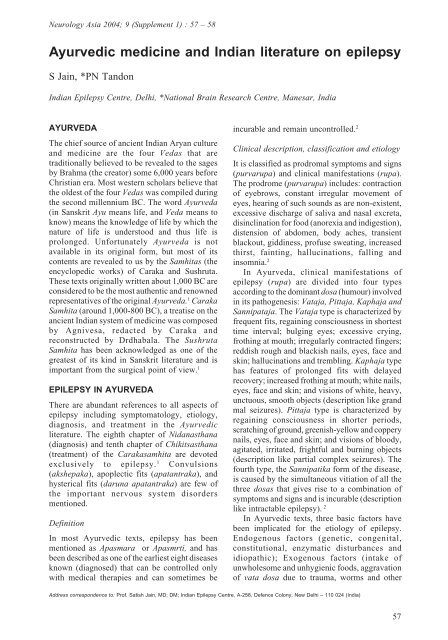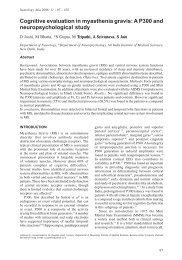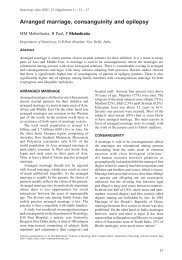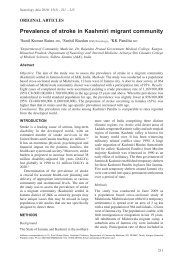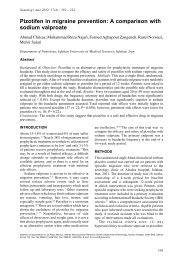Ayurvedic medicine and Indian literature on epilepsy - Neurology Asia
Ayurvedic medicine and Indian literature on epilepsy - Neurology Asia
Ayurvedic medicine and Indian literature on epilepsy - Neurology Asia
Create successful ePaper yourself
Turn your PDF publications into a flip-book with our unique Google optimized e-Paper software.
<strong>Neurology</strong> <strong>Asia</strong> 2004; 9 (Supplement 1) : 57 – 58<br />
<str<strong>on</strong>g>Ayurvedic</str<strong>on</strong>g> <str<strong>on</strong>g>medicine</str<strong>on</strong>g> <str<strong>on</strong>g>and</str<strong>on</strong>g> <str<strong>on</strong>g>Indian</str<strong>on</strong>g> <str<strong>on</strong>g>literature</str<strong>on</strong>g> <strong>on</strong> <strong>epilepsy</strong><br />
S Jain, *PN T<str<strong>on</strong>g>and</str<strong>on</strong>g><strong>on</strong><br />
<str<strong>on</strong>g>Indian</str<strong>on</strong>g> Epilepsy Centre, Delhi, *Nati<strong>on</strong>al Brain Research Centre, Manesar, India<br />
AYURVEDA<br />
The chief source of ancient <str<strong>on</strong>g>Indian</str<strong>on</strong>g> Aryan culture<br />
<str<strong>on</strong>g>and</str<strong>on</strong>g> <str<strong>on</strong>g>medicine</str<strong>on</strong>g> are the four Vedas that are<br />
traditi<strong>on</strong>ally believed to be revealed to the sages<br />
by Brahma (the creator) some 6,000 years before<br />
Christian era. Most western scholars believe that<br />
the oldest of the four Vedas was compiled during<br />
the sec<strong>on</strong>d millennium BC. The word Ayurveda<br />
(in Sanskrit Ayu means life, <str<strong>on</strong>g>and</str<strong>on</strong>g> Veda means to<br />
know) means the knowledge of life by which the<br />
nature of life is understood <str<strong>on</strong>g>and</str<strong>on</strong>g> thus life is<br />
prol<strong>on</strong>ged. Unfortunately Ayurveda is not<br />
available in its original form, but most of its<br />
c<strong>on</strong>tents are revealed to us by the Samhitas (the<br />
encyclopedic works) of Caraka <str<strong>on</strong>g>and</str<strong>on</strong>g> Sushruta.<br />
These texts originally written about 1,000 BC are<br />
c<strong>on</strong>sidered to be the most authentic <str<strong>on</strong>g>and</str<strong>on</strong>g> renowned<br />
representatives of the original Ayurveda. 1 Caraka<br />
Samhita (around 1,000-800 BC), a treatise <strong>on</strong> the<br />
ancient <str<strong>on</strong>g>Indian</str<strong>on</strong>g> system of <str<strong>on</strong>g>medicine</str<strong>on</strong>g> was composed<br />
by Agnivesa, redacted by Caraka <str<strong>on</strong>g>and</str<strong>on</strong>g><br />
rec<strong>on</strong>structed by Drdhabala. The Sushruta<br />
Samhita has been acknowledged as <strong>on</strong>e of the<br />
greatest of its kind in Sanskrit <str<strong>on</strong>g>literature</str<strong>on</strong>g> <str<strong>on</strong>g>and</str<strong>on</strong>g> is<br />
important from the surgical point of view. 1<br />
EPILEPSY IN AYURVEDA<br />
There are abundant references to all aspects of<br />
<strong>epilepsy</strong> including symptomatology, etiology,<br />
diagnosis, <str<strong>on</strong>g>and</str<strong>on</strong>g> treatment in the <str<strong>on</strong>g>Ayurvedic</str<strong>on</strong>g><br />
<str<strong>on</strong>g>literature</str<strong>on</strong>g>. The eighth chapter of Nidanasthana<br />
(diagnosis) <str<strong>on</strong>g>and</str<strong>on</strong>g> tenth chapter of Chikitsasthana<br />
(treatment) of the Carakasamhita are devoted<br />
exclusively to <strong>epilepsy</strong>. 1 C<strong>on</strong>vulsi<strong>on</strong>s<br />
(akshepaka), apoplectic fits (apatantraka), <str<strong>on</strong>g>and</str<strong>on</strong>g><br />
hysterical fits (daruna apatantraka) are few of<br />
the important nervous system disorders<br />
menti<strong>on</strong>ed.<br />
Definiti<strong>on</strong><br />
In most <str<strong>on</strong>g>Ayurvedic</str<strong>on</strong>g> texts, <strong>epilepsy</strong> has been<br />
menti<strong>on</strong>ed as Apasmara or Apasmrti, <str<strong>on</strong>g>and</str<strong>on</strong>g> has<br />
been described as <strong>on</strong>e of the earliest eight diseases<br />
known (diagnosed) that can be c<strong>on</strong>trolled <strong>on</strong>ly<br />
with medical therapies <str<strong>on</strong>g>and</str<strong>on</strong>g> can sometimes be<br />
incurable <str<strong>on</strong>g>and</str<strong>on</strong>g> remain unc<strong>on</strong>trolled. 2<br />
Clinical descripti<strong>on</strong>, classificati<strong>on</strong> <str<strong>on</strong>g>and</str<strong>on</strong>g> etiology<br />
It is classified as prodromal symptoms <str<strong>on</strong>g>and</str<strong>on</strong>g> signs<br />
(purvarupa) <str<strong>on</strong>g>and</str<strong>on</strong>g> clinical manifestati<strong>on</strong>s (rupa).<br />
The prodrome (purvarupa) includes: c<strong>on</strong>tracti<strong>on</strong><br />
of eyebrows, c<strong>on</strong>stant irregular movement of<br />
eyes, hearing of such sounds as are n<strong>on</strong>-existent,<br />
excessive discharge of saliva <str<strong>on</strong>g>and</str<strong>on</strong>g> nasal excreta,<br />
disinclinati<strong>on</strong> for food (anorexia <str<strong>on</strong>g>and</str<strong>on</strong>g> indigesti<strong>on</strong>),<br />
distensi<strong>on</strong> of abdomen, body aches, transient<br />
blackout, giddiness, profuse sweating, increased<br />
thirst, fainting, hallucinati<strong>on</strong>s, falling <str<strong>on</strong>g>and</str<strong>on</strong>g><br />
insomnia. 2<br />
In Ayurveda, clinical manifestati<strong>on</strong>s of<br />
<strong>epilepsy</strong> (rupa) are divided into four types<br />
according to the dominant dosa (humour) involved<br />
in its pathogenesis: Vataja, Pittaja, Kaphaja <str<strong>on</strong>g>and</str<strong>on</strong>g><br />
Sannipataja. The Vataja type is characterized by<br />
frequent fits, regaining c<strong>on</strong>sciousness in shortest<br />
time interval; bulging eyes; excessive crying,<br />
frothing at mouth; irregularly c<strong>on</strong>tracted fingers;<br />
reddish rough <str<strong>on</strong>g>and</str<strong>on</strong>g> blackish nails, eyes, face <str<strong>on</strong>g>and</str<strong>on</strong>g><br />
skin; hallucinati<strong>on</strong>s <str<strong>on</strong>g>and</str<strong>on</strong>g> trembling. Kaphaja type<br />
has features of prol<strong>on</strong>ged fits with delayed<br />
recovery; increased frothing at mouth; white nails,<br />
eyes, face <str<strong>on</strong>g>and</str<strong>on</strong>g> skin; <str<strong>on</strong>g>and</str<strong>on</strong>g> visi<strong>on</strong>s of white, heavy,<br />
unctuous, smooth objects (descripti<strong>on</strong> like gr<str<strong>on</strong>g>and</str<strong>on</strong>g><br />
mal seizures). Pittaja type is characterized by<br />
regaining c<strong>on</strong>sciousness in shorter periods,<br />
scratching of ground, greenish-yellow <str<strong>on</strong>g>and</str<strong>on</strong>g> coppery<br />
nails, eyes, face <str<strong>on</strong>g>and</str<strong>on</strong>g> skin; <str<strong>on</strong>g>and</str<strong>on</strong>g> visi<strong>on</strong>s of bloody,<br />
agitated, irritated, frightful <str<strong>on</strong>g>and</str<strong>on</strong>g> burning objects<br />
(descripti<strong>on</strong> like partial complex seizures). The<br />
fourth type, the Sannipatika form of the disease,<br />
is caused by the simultaneous vitiati<strong>on</strong> of all the<br />
three dosas that gives rise to a combinati<strong>on</strong> of<br />
symptoms <str<strong>on</strong>g>and</str<strong>on</strong>g> signs <str<strong>on</strong>g>and</str<strong>on</strong>g> is incurable (descripti<strong>on</strong><br />
like intractable <strong>epilepsy</strong>). 2<br />
In <str<strong>on</strong>g>Ayurvedic</str<strong>on</strong>g> texts, three basic factors have<br />
been implicated for the etiology of <strong>epilepsy</strong>.<br />
Endogenous factors (genetic, c<strong>on</strong>genital,<br />
c<strong>on</strong>stituti<strong>on</strong>al, enzymatic disturbances <str<strong>on</strong>g>and</str<strong>on</strong>g><br />
idiopathic); Exogenous factors (intake of<br />
unwholesome <str<strong>on</strong>g>and</str<strong>on</strong>g> unhygienic foods, aggravati<strong>on</strong><br />
of vata dosa due to trauma, worms <str<strong>on</strong>g>and</str<strong>on</strong>g> other<br />
Address corresp<strong>on</strong>dence to: Prof. Satish Jain, MD; DM; <str<strong>on</strong>g>Indian</str<strong>on</strong>g> Epilepsy Centre, A-258, Defence Col<strong>on</strong>y, New Delhi – 110 024 (India)<br />
57
<strong>Neurology</strong> <strong>Asia</strong> 2004; 9 (Supplement 1)<br />
envir<strong>on</strong>mental factors); <str<strong>on</strong>g>and</str<strong>on</strong>g> Psychological factors<br />
(excessive worry, grief, fear, passi<strong>on</strong>, anger,<br />
anxiety <str<strong>on</strong>g>and</str<strong>on</strong>g> excitement). The aggravated dosa<br />
spreads throughout the body through the nerves<br />
(dhamanis) leading to the manifestati<strong>on</strong> of the<br />
epileptic fit in the form of shaking jerks or<br />
c<strong>on</strong>vulsi<strong>on</strong>s (akshepaka) or episodes of brief<br />
unc<strong>on</strong>sciousness without shaking (apatantraka). 2<br />
Clinical examinati<strong>on</strong> <str<strong>on</strong>g>and</str<strong>on</strong>g> diagnosis<br />
A comprehensive evaluati<strong>on</strong> of the patient (rogi<br />
pariksha) preceeds the disease diagnosis (roga<br />
pariksha). Ayurveda emphasizes <strong>on</strong> a detailed<br />
history of the patient for a correct diagnosis.<br />
TREATMENT OF EPILEPSY<br />
Various treatment modalities that include str<strong>on</strong>g<br />
eliminati<strong>on</strong> <str<strong>on</strong>g>and</str<strong>on</strong>g> alleviati<strong>on</strong> therapies, depending<br />
up<strong>on</strong> specific requirements are menti<strong>on</strong>ed as being<br />
useful for <strong>epilepsy</strong> patients. When <strong>epilepsy</strong> is<br />
associated with extrinsic factors, then mantras<br />
(hymns) have been recommended. The physician<br />
is advised to first take steps for the awakening of<br />
heart channels <str<strong>on</strong>g>and</str<strong>on</strong>g> mind blocked by dosas<br />
(humors) by drastic emesis (Vatika Apasmara),<br />
enema (Paittika Apasmara) <str<strong>on</strong>g>and</str<strong>on</strong>g> purgatives<br />
(Slaismika Apasmara). Drug formulati<strong>on</strong>s have<br />
been recommended <strong>on</strong>ly after the patient has<br />
been cleansed by all means <str<strong>on</strong>g>and</str<strong>on</strong>g> c<strong>on</strong>soled well. 1<br />
A wide variety of ghrtas (purified butters)<br />
have been recommended for internal use. One of<br />
the most important am<strong>on</strong>g these is Maha Panca<br />
Gavya Ghrta. Use of mixtures of ghrta <str<strong>on</strong>g>and</str<strong>on</strong>g> taila<br />
(oil) cooked with drugs has also been menti<strong>on</strong>ed.<br />
Oils cooked with different herbal <str<strong>on</strong>g>and</str<strong>on</strong>g> animal<br />
products have been recommended for anointing<br />
the body of the patient. Even nasyas (nasal<br />
applicati<strong>on</strong>s) have been recommended. The use<br />
of a wide variety of anjanas (collyriums) <str<strong>on</strong>g>and</str<strong>on</strong>g><br />
anjana vartikas (collyriu sticks) to bring the<br />
patient to senses has also been menti<strong>on</strong>ed. A<br />
variety of <str<strong>on</strong>g>Ayurvedic</str<strong>on</strong>g> <str<strong>on</strong>g>medicine</str<strong>on</strong>g>s for <strong>epilepsy</strong><br />
available in the <str<strong>on</strong>g>Indian</str<strong>on</strong>g> market include:<br />
Asvag<str<strong>on</strong>g>and</str<strong>on</strong>g>hadyarishta, Bali Tail, Brahmi ghruta,<br />
ch<str<strong>on</strong>g>and</str<strong>on</strong>g>anadi tail, Chaturmukha rasa, haratala<br />
bhasma, Kalyanaka ghruta, Kumaryasava,<br />
Mahakalayanaka ghruta, Mahamrutyunjaya<br />
rasa,Rajata bhasma, saarasvatarishta,<br />
sarpag<str<strong>on</strong>g>and</str<strong>on</strong>g>ha vati, Svarna bhasma,<br />
Svarnamakshika bhasma, Vaatakulantaka rasa,<br />
<str<strong>on</strong>g>and</str<strong>on</strong>g> Yogendra rasa. 2<br />
The modes of administrati<strong>on</strong> of drugs for<br />
<strong>epilepsy</strong> recommended in Ayurveda include<br />
external applicati<strong>on</strong>s, internal use, applicati<strong>on</strong> in<br />
58<br />
the eyes <str<strong>on</strong>g>and</str<strong>on</strong>g> nose. The <strong>on</strong>ly first-aid measure<br />
recommended in <strong>epilepsy</strong> is blood-letting<br />
(Siravedha) from the veins of the temples.<br />
Cauterizati<strong>on</strong> of both the parietal b<strong>on</strong>es with<br />
needles (Soocivedha) has also been menti<strong>on</strong>ed. 1<br />
THE FUTURE<br />
Practiti<strong>on</strong>ers of modern <str<strong>on</strong>g>medicine</str<strong>on</strong>g> <str<strong>on</strong>g>and</str<strong>on</strong>g> ancient<br />
<str<strong>on</strong>g>medicine</str<strong>on</strong>g> like Ayurveda should join h<str<strong>on</strong>g>and</str<strong>on</strong>g>s with<br />
researchers to underst<str<strong>on</strong>g>and</str<strong>on</strong>g> the scientific basis of<br />
<str<strong>on</strong>g>Ayurvedic</str<strong>on</strong>g> therapies using the current scientific<br />
principles <str<strong>on</strong>g>and</str<strong>on</strong>g> technologies. Modern <str<strong>on</strong>g>and</str<strong>on</strong>g> Ancient<br />
<str<strong>on</strong>g>medicine</str<strong>on</strong>g> systems should be combined to plan<br />
effective health-care delivery systems for better<br />
<strong>epilepsy</strong> care. <str<strong>on</strong>g>Ayurvedic</str<strong>on</strong>g> therapies could be<br />
scientifically tested <str<strong>on</strong>g>and</str<strong>on</strong>g> then used at least as add<strong>on</strong><br />
therapies like the new anti-epileptic drugs<br />
(AEDs). <str<strong>on</strong>g>Ayurvedic</str<strong>on</strong>g> <str<strong>on</strong>g>and</str<strong>on</strong>g> other ancient therapies<br />
could form the basis of the future “New AEDs”.<br />
REFERENCES<br />
1. T<str<strong>on</strong>g>and</str<strong>on</strong>g><strong>on</strong> PN. Ayurveda <str<strong>on</strong>g>and</str<strong>on</strong>g> <strong>epilepsy</strong>. In: T<str<strong>on</strong>g>and</str<strong>on</strong>g><strong>on</strong> PN,<br />
ed. Epilepsy in India: Report based <strong>on</strong> a multicentric<br />
study <strong>on</strong> epidemiology of <strong>epilepsy</strong> carried out as a<br />
PL 480 funded project of the <str<strong>on</strong>g>Indian</str<strong>on</strong>g> Council of<br />
Medical Research, New Delhi, India, 1989: 176-80.<br />
2. Bhatt HA, Gogtay NJ, Dalvi SS, Kshirsagar NA.<br />
Epilepsy. In: Mishra LC, ed: Scientific basis for<br />
<str<strong>on</strong>g>Ayurvedic</str<strong>on</strong>g> therapies. Washingt<strong>on</strong> DC: CRC Press,<br />
2003: 427-37


